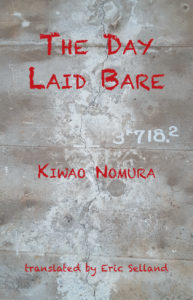 The Poetry Book Society in the UK has chosen The Day Laid Bare, Eric Selland‘s translation of ヌードな日 (Nuudo na hi) by Kiwao Nomura, as one of its two recommended translations for its winter 2020 season! Click here to go to the PBS website.
The Poetry Book Society in the UK has chosen The Day Laid Bare, Eric Selland‘s translation of ヌードな日 (Nuudo na hi) by Kiwao Nomura, as one of its two recommended translations for its winter 2020 season! Click here to go to the PBS website.
In The Day Laid Bare, Kiwao Nomura takes us on a tour through hell on earth, much like Dante’s Inferno. The parades of flesh winding their way through Nomura’s poem are living creatures both human and non-human, or often subhuman, but who nevertheless ultimately embody the human condition. The title, The Day Laid Bare, speaks to human life stripped down to its most basic reality – vulnerable and powerless. The entire work is overshadowed by the colossal earthquake and tsunami which destroyed much of the northeastern region of Japan in March of 2011. Thus, although expressed in the language of the absurd and the Felliniesque, Kiwao Nomura’s The Day Laid Bare has an existential urgency.
Kiwao Nomura is a thrillingly unpredictable poet who never fails to challenge the limits of the possible and the linear. If indeed, as Pound wrote many years ago, certain poetry can resemble a ‘dance of the intellect among words,’ then we might think of Nomura’s work as a kind of tarantella, or perhaps a sword dance, or flamenco dance, or a rice dance. Satan tango? Quick step? Moon walk? Fire dance? Perhaps all, since Nomura is a poet of international range and address, a poet for whom the body of the poem is constantly dissolving and reforming in its path toward discovery of that sublime engine of perception, the ungovernable imagination. – Michael Palmer (author of The Laughter of the Sphinx)
Kiwao Nomura’s The Day Laid Bare came in the aftermath of the 2011 devastation caused by the earthquake and tsunami in Japan. Now Eric Selland’s new translation is able to speak to our world a decade later too. The writing registers and confronts a sense of existential crisis, danger and destruction with startling vitality. The ‘flesh’ of Nomura’s poems – a recurrent term – is related to every other life form on the planet with bleak intensity. Life is stripped back to bare bones which then beat out new rhythms to the ongoing necessities of dance. The desperation is knitted inextricably to a buoyant lilt, the lustrous and the filthy, shrieks and bird song. Violence, nonchalance, the dissolution of the human are conveyed in clashing registers which juxtapose diverse literary histories and cultures. This stunning book, an energising danse macabre for today, concludes with six pages of illuminating notes examining the workings and contexts of the text. – Peter Hughes
Billy Mills has posted a review of The Day Laid Bare; he writes of the double helix structure of the poem, of Nomura’s ‘surgical examination of the human’, and of many other aspects (genetic, Boschian, Buddhist) of the poem. He finishes his review by saying: ‘This is an endlessly fascinating book, opening up a door into a body of Japanese poetry that was new to me, and I suspect will be new to many western readers. Both Selland and Isobar are to be thanked for bringing out this very interesting translation.’ Thank you very much, Billy. Click here to read the whole review.
1 October 2020, 84 pages, 5.5 x 8.5 in / 216 x 140 mm, ISBN 978-4-907359-32-4
Click here to read excerpts from The Day Laid Bare.
Click here to buy from Amazon in Japan, here for Amazon in the UK, and here for Amazon in the US.
Acknowledgements
Some of the translations of poems in The Day Laid Bare have previously appeared in Big Bridge, Eleven-Eleven, Upstairs at Duroc, and Two Lines. With thanks to the editors.
‘Notes towards an Introduction’, an essay by Eric Selland on Kiwao Nomura’s ヌードな日 (Nude Day) can be found on Eric’s website, here. A Japanese translation of this essay appeared in the Gendaishi Techo special issue on Nomura in 2017.